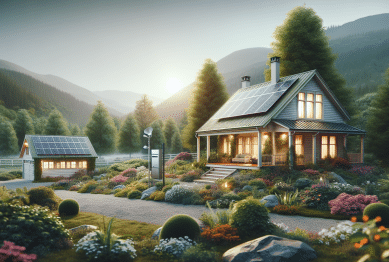Vertical gardens bring life to compact spaces and offer an efficient way to enjoy greenery at home. Explore how they can maximize small areas, support sustainability, and provide a stunning visual impact. This guide will show how anyone can successfully introduce vertical gardening ideas indoors or out.
Benefits of Vertical Gardens in Home Spaces
Vertical gardens are revolutionizing the way people approach home greenery, especially in urban environments. With limited floor space, growing up instead of out is an inventive solution. Not only do these gardens save space, but they also turn blank walls and fences into thriving green canvases. Many find that introducing a living wall or a series of hanging planters creates a sense of tranquility and can even improve air quality within apartments or homes. Recent research highlights the positive impact of green walls on internal air purification and mental well-being (https://www.epa.gov/indoor-air-quality-iaq/indoor-plants-and-air-quality).
For those seeking a more sustainable lifestyle, vertical gardening brings real advantages. Homeowners and renters alike are discovering how easy it is to grow edibles, such as lettuce or herbs, even on balconies. The efficient use of vertical space allows for higher yield, reduces the need for excessive watering, and minimizes pest issues. Green walls act as natural insulation, moderating indoor temperatures, and potentially lowering energy bills. Vertical systems are often designed to be water-efficient, using drip irrigation or recycled materials, supporting eco-friendly choices in home design.
Beyond functionality, vertical gardens add undeniable aesthetic value. Whether it’s a simple DIY herb wall in the kitchen or a dramatic exterior living wall, the lush textures and patterns captivate both residents and visitors. Vertical gardens can also serve as privacy screens or soften the appearance of hard surfaces, making patios and balconies feel more inviting. Homeowners enjoy the flexibility to experiment with different plant varieties and decorative arrangements, keeping home decor fresh while supporting biodiversity right outside their windows.
Choosing Plants for Your Vertical Garden
Plant selection is a pivotal step in vertical gardening success. The environment—light, humidity, and space—determines which varieties will thrive. Many people opt for resilient, low-maintenance species such as pothos, philodendron, or spider plants, perfect for indoor vertical gardens. For outdoor installations, ferns, succulents, and even small vegetables can create vibrant, functional displays. Edible gardens are especially popular for those who wish to supplement meals with homegrown greens or aromatic herbs, and many find that rotating crops seasonally keeps their display productive and eye-catching (https://extension.psu.edu/vertical-gardening).
In addition to environmental factors, the purpose of your garden influences your plant choices. A privacy wall of bamboo or tall grasses provides screening and shade, while a vertical array of flowering plants attracts pollinators to a balcony or yard. When aesthetics are the focus, mixing textures, leaf shapes, and colors helps create dynamic arrangements. It’s also important to consider the weight of mature plants and how their roots will grow in containers or living wall modules. Thoughtful planning can help prevent structural issues and ensure the garden flourishes throughout the year.
Some hobbyists enjoy experimenting with unusual or native varieties that require less water or maintenance. Vertical systems with built-in irrigation make growing thirsty species, like ferns, possible, even in drier climates. For beginners, starting with herbs—like basil, thyme, or mint—provides easy wins, while advanced gardeners might try small fruiting vines or compact vegetables. Regardless of experience level, selecting healthy plants, amending the soil, and regular pruning contribute to a vibrant vertical display that lasts for seasons.
Creative Vertical Garden Ideas for Small Homes
Small spaces encourage inventive thinking when it comes to vertical gardens. Wall-mounted planters offer a sense of depth and structure to bare areas, making tiny apartments feel lush. Some residents transform old ladders, pallets, or shoe organizers into living displays. These upcycled solutions prove budget-friendly and add personality to any home. Living art installations with succulents or air plants highlight the versatility of vertical gardening without requiring much space or expertise (https://hgic.clemson.edu/factsheet/vertical-gardening/).
Over kitchen countertops, tiered herb gardens keep fresh flavors within reach all year. Indoor wall gardens with automatic lighting systems can provide lush greenery even in windowless rooms or offices. Hanging pots from the ceiling maximizes vertical space, and creative arrangements of wall pockets introduce a sculptural element to interior design. Bathrooms, often overlooked, can turn into tropical retreats with vertical mosses or humidity-loving foliage, blending decor and utility.
Outdoor walls come alive with vertical vegetable patches or flowering vines. Fence lines or balcony rails support trellised beans, strawberries, or cascading petunias. Some homeowners experiment with modular planting systems, allowing for easy swaps when planting new seasons or freshening arrangements. By combining different ideas and materials, vertical gardens turn restrictive spaces into mini-oases overflowing with color and texture. The adaptability of this approach ensures inspiration for both renters and homeowners alike.
DIY Vertical Garden Construction and Materials
Starting a vertical garden project doesn’t require expensive supplies or professional help for most designs. Many find success with recycled pallets, plastic bottles, or pre-made wall panels. Choosing the right substrate and structure is crucial. Lightweight potting mixes, good drainage, and sturdy support help maintain plant health and reduce the risk of mold or root rot. Watering systems—like drip irrigation—can be installed easily, improving efficiency and reducing daily upkeep for larger installations (https://extension.umn.edu/how/diy-living-wall).
Popular materials for vertical gardening range from metal mesh and plastic grids to wooden slats or felt pockets. Each has unique benefits. Modular panels let you change plants or swap out specimens as the seasons shift. Felt pouches or geotextiles offer excellent airflow, supporting root health. For balcony or fence displays, consider solar-powered irrigation or moisture sensors for smart maintenance. Upcycled or locally sourced materials keep the project affordable and add a personal touch to the final design.
Setting up a vertical garden is often a weekend project. After measuring your space, ensure your frame is securely anchored. Install your planters, soil, and chosen plants, being careful not to overcrowd roots. Test your irrigation system and inspect for leaks. As the garden grows, routine care—such as trimming, cleaning planter surfaces, and checking soil moisture—keeps your living wall healthy and vibrant. Over time, plants will fill in, breathing new life into even the smallest niche of your home.
Caring for and Maintaining Vertical Gardens
Regular maintenance is the key to lasting vertical garden displays, indoors or outdoors. Watering frequency will depend on the plant type, exposure, and the type of irrigation system in place. Self-watering planters and automated drippers offer peace of mind for busy homeowners. Mulching can help reduce water evaporation, while routine checks for pests and diseases prevent problems from spreading. Many gardeners report that vertical gardens tend to have fewer soil-borne issues, making care simpler overall (https://pubs.ext.vt.edu/426/426-020/426-020.html).
Pruning and deadheading spent blooms promote bushy growth and continuous flowering in ornamental vertical gardens. For edible displays, harvesting regularly keeps plants productive. Fertilization is necessary, especially for dense installations, as nutrients may leach more quickly than in traditional beds. Consider organic, slow-release formulas or liquid feeds periodically based on plant needs and growth stage. When replacing plants, rotate with complementary species to refresh soil and minimize disease risk.
Monitoring light and temperature is also essential for thriving displays. As seasons change, adjust plant placement or provide supplemental grow lighting where natural light is insufficient. For outdoor systems, winterizing steps may be needed by covering roots or relocating planters indoors. With minimal regular effort, vertical gardens can remain lush and healthy year-round, providing beauty and utility for years to come. The rewards make these gardens a lasting joy for gardeners of any skill level.
Mistakes to Avoid and Pro Tips for Vertical Gardening
While vertical gardening opens creative possibilities, there are common missteps. Overcrowding is a frequent error, resulting in poor airflow and weak growth. It’s tempting to fill every pocket or space from the start, but allowing room for expansion reduces the risk of fungal infections. Some beginners also neglect the importance of sturdy frames, leading to potential collapses or plant loss, especially outdoors. It’s wise to choose mounting hardware rated for anticipated load (https://edis.ifas.ufl.edu/publication/EP502).
Another pitfall involves ignoring microclimates in the home. Not every wall, balcony, or fence will receive the same light, wind, or humidity. Before planting, spend time observing your chosen site throughout the day to understand where shade and sun fall. Matching plant varieties to these conditions ensures healthy, low-stress growth. Seasoned vertical gardeners also advise against over-fertilizing, which can cause salt buildup in compact soil pockets and stress plant roots.
For those looking to elevate results, integrating smart irrigation or moisture sensors can reduce maintenance and increase reliability. Modular systems make seasonal updates easy and keep the garden interesting all year. Finally, don’t overlook the value of experimentation—trying new plant species, creative patterns, or lighting arrangements. Each vertical garden is unique, evolving with personal tastes and local conditions while offering ongoing satisfaction.
References
1. U.S. Environmental Protection Agency. (n.d.). Indoor plants and air quality. Retrieved from https://www.epa.gov/indoor-air-quality-iaq/indoor-plants-and-air-quality
2. Penn State Extension. (n.d.). Vertical gardening. Retrieved from https://extension.psu.edu/vertical-gardening
3. Clemson Cooperative Extension. (n.d.). Vertical gardening: A growing trend. Retrieved from https://hgic.clemson.edu/factsheet/vertical-gardening/
4. University of Minnesota Extension. (n.d.). DIY living wall tips. Retrieved from https://extension.umn.edu/how/diy-living-wall
5. Virginia Cooperative Extension. (n.d.). Gardening basics: Maintenance and care. Retrieved from https://pubs.ext.vt.edu/426/426-020/426-020.html
6. University of Florida IFAS Extension. (n.d.). Vertical gardening in small spaces. Retrieved from https://edis.ifas.ufl.edu/publication/EP502









